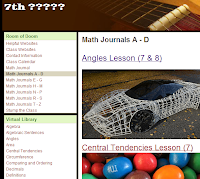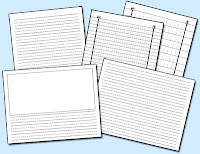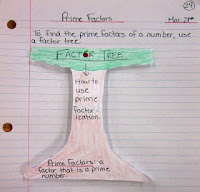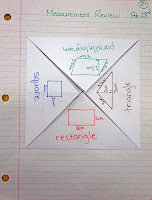 Math journals are great, this teacher has adapted her lessons and math journal to the online version. You can check out the link below, but the teachers who contribute to the blog have just got one-to-one with laptops and this is a great idea for any math classroom. They have all of their projects for the students to do linked to a Google site.
Math journals are great, this teacher has adapted her lessons and math journal to the online version. You can check out the link below, but the teachers who contribute to the blog have just got one-to-one with laptops and this is a great idea for any math classroom. They have all of their projects for the students to do linked to a Google site.http://experimenting-in-education.blogspot.com/math-journal-days.html
I also did several lessons that involved post its. Middle school students love post its. Use them whenever possible. Using Post-it notes is a great way for a flip and reveal technique. Students can use them to study terms or vocabulary. There are others featured on the website below that uses post-it notes for variables in expressions and inequalities. http://thenumbertwentyone.wordpress.com/math-notebook/
This year I am also going to include a latch. I am hoping this helps with things falling out. I have invested in gold brads and twine for this. I will use an ice pick to poke the holes for each student.
I came up with the idea of a folded sleeve with a sliding chart insert, containing the phrases that often confuse kids or cause them to second-guess their translations from words into math. Here's what the finished product looks like. I used OmniGraffle to make the sleeve template and I used Pages, Preview, and Adobe Acrobat to make the insert. If you want to make your own inserts, you'll need to set up your own table (Word, Pages, Excel, etc) making sure that your row height is exactly 1/4 inch. Your LHS cells should be 1 9/16" wide and your RHS cells should be 1/2 inch wide. You can have about 19 or 20 rows, depending on what you put in them.
 http://www.ateacherstreasure.com/interactive-student-notebook
http://www.ateacherstreasure.com/interactive-student-notebookhttp://www.dotolearn.com/activities/writingtools/index.htm
http://www.mathnspire.net/
http://www.rundesroom.com/
http://themiddleschoolmouth.blogspot.com/

A place where you can print your own writing paper, great for interactive notebooks or for math journals. Some of the layouts are good practice for students. Almost like smaller graphic organizers.

 The one to the side is equivalent fractions. I've been using pizza fractions for years (and judging from the amount of pins on pinterest, so has everyone else). I gave each student a circle and had them draw a smaller circle around the edge to make a crust for the pizza. We then folded our circle into sixteenths. I gave students the learning goal and instructions to make the pizza: 1/4 cheese, 1/4 pepperoni, 1/8 mushrooms, 1/8 sausage, 3/16 green olives (or alligator nostrils as my four-year old calls them), and 1/16 anchovies (had to get something in there to "gross out" my plethora of boys in the class). We discussed that 2/8 equaled 1/4, and 2/4 equaled 1/2, and so on ... We then cut along the fraction lines and peeled back the sections so we could practice our converting to decimals and percents (still working on that concept from last week).
The one to the side is equivalent fractions. I've been using pizza fractions for years (and judging from the amount of pins on pinterest, so has everyone else). I gave each student a circle and had them draw a smaller circle around the edge to make a crust for the pizza. We then folded our circle into sixteenths. I gave students the learning goal and instructions to make the pizza: 1/4 cheese, 1/4 pepperoni, 1/8 mushrooms, 1/8 sausage, 3/16 green olives (or alligator nostrils as my four-year old calls them), and 1/16 anchovies (had to get something in there to "gross out" my plethora of boys in the class). We discussed that 2/8 equaled 1/4, and 2/4 equaled 1/2, and so on ... We then cut along the fraction lines and peeled back the sections so we could practice our converting to decimals and percents (still working on that concept from last week).
Pages 4 - 8 are used to set-up the table of contents. This is a great tool to help kids not only take better notes, but to help them learn how to use their resources when they get stuck. I mark off along the margains and title them in order "Date", "Title" and "Page #" (my date is left blank b/c I use mine from year to year). I made each chapter a different color so that it's easy to see where chapter breaks are.

We started on prime factors. So of course, we had to make a foldable factor "tree".
We had our big three-part lesson on prime factors, and so many students went back to their math journals to see the factor tree.
 For this unit we are going to study the properties, nets, volume and surface area for the different 3D shapes my students are responsible for learning. They are using this sheet as a title page for their unit. I had students draw a net for a cube that had 4 cm x 4 cm faces. Most of them remembered how to do this, and for the ones that were having difficulty, I showed them a model of a net for a cube. I was also modeling how to draw it under the elmo. After the nets were drawn, we recorded different characteristics for the cube on each of the faces: faces, edges, vertices, other net views, surface area and volume, and a sketch). We then used the formula to find the volume and surface area of the net we had drawn. We wrote this down on the paper beside the foldable. We only glued one face to the paper (the one where "other net shapes" was written), so we could still "fold" our net into the 3D shape.
For this unit we are going to study the properties, nets, volume and surface area for the different 3D shapes my students are responsible for learning. They are using this sheet as a title page for their unit. I had students draw a net for a cube that had 4 cm x 4 cm faces. Most of them remembered how to do this, and for the ones that were having difficulty, I showed them a model of a net for a cube. I was also modeling how to draw it under the elmo. After the nets were drawn, we recorded different characteristics for the cube on each of the faces: faces, edges, vertices, other net views, surface area and volume, and a sketch). We then used the formula to find the volume and surface area of the net we had drawn. We wrote this down on the paper beside the foldable. We only glued one face to the paper (the one where "other net shapes" was written), so we could still "fold" our net into the 3D shape.We made a 4-corner foldable to review the formulas for the area and perimeter of the different shapes we learned. On the inside of each flap we found the area and perimeter of each shape (the students had to measure the dimensions of the shape they drew on the outside of each flap).
This is an example of a pullout, students could write the problem they did on the board. Students have a pull-out tab. Students then write what they were thinking when they did the problem on the pull-out sheet. When finished it can go in the interactive notebook for students to use in class and on reviews on how to do the problems.

Students use this as a place they can keep exit tickets or small review examples and graphs that the teachers handout. It wouldn't obviously say Reader's Toolbox, but a mathematical toolbox is a great way keep things in an envelope style. Students could keep homework passes or any other slips they receive in math class.
There are some "extras" you can add to your notebook. Above you will see ribbon that has been taped into the book. That served as a bookmark. I had the students knot the end because ribbon tends to fray. I liked the bookmark. Another teacher I know had student put beads on the end of their bookmark.
I also glued an envelope to the back cover. I saw another teacher do that and she used it for loose leaf papers. I recently used mine to store the accordion card project while students were working on it. The same teacher also glued envelopes to the front cover and it stored things like homework and bathroom passes.
Hot glue or tape a piece of ribbon to the inside cover. This makes it easier for students to flip to a particular portion of the math notebook much faster. Make sure the end of it is enough to stick out the bottom to go over the top.
Word clouds are a great way to use vocabulary in your interactive math notebook. Create a word cloud that shows a pattern and have students discuss via classroom, groups, or online forum. Have students come up an original way to use a word cloud to tell a mathematical story. More information can be found here.
Giving students writing prompts to put in their interactive math journals is a good idea to get students writing or even drawing more in their math notebooks. I normally do a learning inventory on what they want to learn at the beginning of the year. It gives the students a good chance to get writing on the pages and incorporate writing into the curriculum.
Sticky notes made with graph paper printed on them. Great for students interactive notebooks. They are pretty cheap at 2$ for 50 sheets. You can find them here at: http://themathguru.tumblr.com/post/20383855169/graphing-made-awesome They are easy to attache to interactive math notebooks to get the right graph every time and make the notebooks look flawless.

On the right there is a math foldable that you can easily place into an interactive notebook. From http://mrswilliamsmath.wordpress.com/ this foldable is portrayed in a how-to. My students are usually quite taken with this foldable and will spend some time opening and closing the middle piece to try to figure out exactly how it works. They used it this year for recording Property Rules and also Exponent Rules.
A math notebook rubric in the first few pages of the interactive notebook will let the students know what the guidelines for the class and how neat and tidy. This rubric uses neat handwriting, information recorded and accurate, table of contents, pages numbered, titles included, and illustrations are accurate. These guidelines will help the students know that they need to keep their interactive notebook the best looking as possible.
First and foremost, I never have to pass out graph paper. We make many tables, charts, and graphs in my class so having their notebook BE graph paper is just divine. Additionally, I teach 6th grade and many of them still have giant handwriting and/or their work is all over the place. With the graph paper notebooks, I can strongly encourage them to put one number in each square. This helps in almost every mathematical procedure that they do. Numbers are small, neat, and all lined up. Beautiful.

On the right there is a math foldable that you can easily place into an interactive notebook. From http://mrswilliamsmath.wordpress.com/ this foldable is portrayed in a how-to. My students are usually quite taken with this foldable and will spend some time opening and closing the middle piece to try to figure out exactly how it works. They used it this year for recording Property Rules and also Exponent Rules.
A math notebook rubric in the first few pages of the interactive notebook will let the students know what the guidelines for the class and how neat and tidy. This rubric uses neat handwriting, information recorded and accurate, table of contents, pages numbered, titles included, and illustrations are accurate. These guidelines will help the students know that they need to keep their interactive notebook the best looking as possible.
First and foremost, I never have to pass out graph paper. We make many tables, charts, and graphs in my class so having their notebook BE graph paper is just divine. Additionally, I teach 6th grade and many of them still have giant handwriting and/or their work is all over the place. With the graph paper notebooks, I can strongly encourage them to put one number in each square. This helps in almost every mathematical procedure that they do. Numbers are small, neat, and all lined up. Beautiful.
Notebook Tips:
- You will probably need one notebook per semester.
- It usually takes us about 30 minutes to set up the notebook initially.
- Have extra blank notebooks on hand it you want to set them up any day in week 1. Someone is not going to have theirs yet. You just give them one of your new, blank ones, email the parent a reminder, and then collect theirs as an extra when they bring it in. You can use this one next semester.
- Use Foldables or half sheets for their notes whenever possible so you don’t have to trim every worksheet you give them. That gets very old, very fast.
- Modeling is the key when doing a math class notebook with younger students. I have 6th and 7th grade, so I made a Powerpoint that shows how to set up the notebook step by step.













Very useful, thanks.
ReplyDeleteCan you share your powerpoint? I teach grade six and I just started with interactive notebooks last week.
ReplyDeleteI don't have a powerpoint, but you can take anything off this site you want.
Deletewhere did you purchase the graph notebooks? the one from staples is so small.
ReplyDeleteI teach in a lower poverty area... we try to make do and use the front and back of each page. I agree I wish they had larger composition notebooks, but we just use the 100 pages ones.
DeleteWe try to make the most out of them... sometimes we run out of pages and have to "attempt" to make extra pages in them.
Excellent ideas here. Some I have never seen before. I'm bookmarking this one.
ReplyDeleteThese are some great ideas and I would love to begin using interactive notebooks this year in my math classes. What I don't understand, though, is how the students know what content to put into their foldables. If they do it individually or in small groups, how do you ensure all the needed content goes in? If you do it together as a class, how do you allow their individual creativity to come out?
ReplyDeleteim definitely going to use the table of contents great ideal
ReplyDeleteThanks for sharing this website!!
ReplyDelete